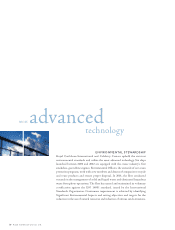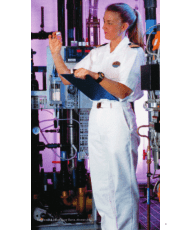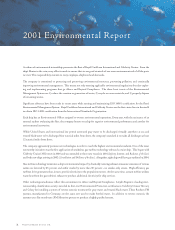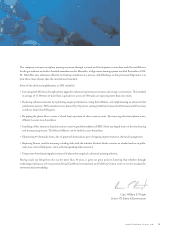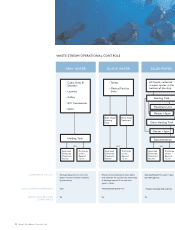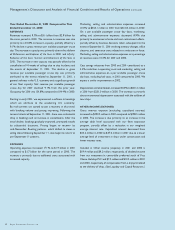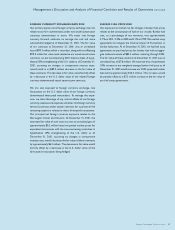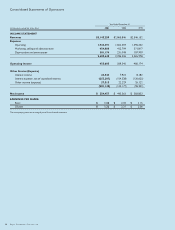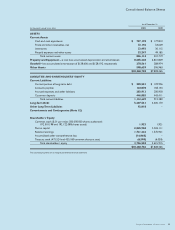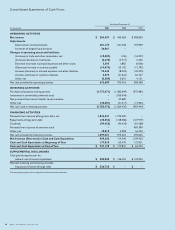Royal Caribbean Cruise Lines 2001 Annual Report Download - page 32
Download and view the complete annual report
Please find page 32 of the 2001 Royal Caribbean Cruise Lines annual report below. You can navigate through the pages in the report by either clicking on the pages listed below, or by using the keyword search tool below to find specific information within the annual report.
Management’s Discussion and Analysis of Financial Condition and Results of Operations (continued)
30 Royal Caribbean Cruises Ltd.
FLEET EXPANSION
Our current fleet expansion program encompasses three distinct
vessel designs known as the Voyager-class, Millennium-class
and Radiance-class. Since 1999, we have taken delivery of
three Voyager, three Millennium and one Radiance class
vessels. We currently operate 22 ships with 45,854 berths.
We have six ships on order. The planned berths and expected
delivery dates of the ships on order are as follows:
Expected
Vessel Delivery Date Berths
Royal Caribbean International
Voyager-class:
Navigator of the Seas 1st Quarter 2003 3,114
Mariner of the Seas 1st Quarter 2004 3,114
Radiance-class: (1)
Brilliance of the Seas 3rd Quarter 2002 2,100
Serenade of the Seas (2) 4th Quarter 2003 2,100
Jewel of the Seas (2) 2nd Quarter 2004 2,100
Celebrity Cruises
Millennium-class:
Constellation 2nd Quarter 2002 2,034
(1) We have two options on Radiance-class vessels with delivery dates in the third
quarters of 2005 and 2006.
(2) These two ships are committed to the new southern European joint venture
with P&O Princess.
We believe the Voyager-class vessels are the largest and the most
innovative passenger cruise ships ever built. The Radiance-class
vessels are a progression from Royal Caribbean International’s
Vision-class vessels, while the Millennium-class ships are a
progression from Celebrity Cruises’ Century-class vessels.
Critical Accounting Policies
Our consolidated financial statements are prepared in accordance
with accounting principles generally accepted in the United
States, which require us to make estimates. (See Notes 1 and
2 to the Consolidated Financial Statements.) Certain of our
accounting policies are deemed “critical,” as they require
management’s highest degree of judgment, estimates and
assumptions. A discussion of what we believe to be our most
critical accounting policies follows:
SHIP ACCOUNTING
Our ships represent our most significant asset, and we state
them at cost less accumulated depreciation and amortization.
Depreciation of vessels, which includes amortization of
vessels under capital leases, is computed net of a 15%
projected residual value using the straight-line method over
estimated service lives of primarily 30 years. Significant vessel
improvement costs are capitalized as additions to the vessel
versus a repair and maintenance activity, which is charged to
expense. Our depreciation and amortization assumptions take
into consideration the impact of anticipated technological
changes, long-term cruise and vacation market conditions and
historical useful lives of similarly-built ships. Given the very
large and complex nature of our ships, our accounting esti-
mates related to ships and determinations of vessel improve-
ment costs to be capitalized require considerable judgment and
are inherently uncertain. Should certain factors or circum-
stances cause us to revise our estimate of ship service lives or
projected residual values, depreciation expense could be mate-
rially lower or higher. If circumstances cause us to change our
assumptions in making determinations as to whether vessel
improvements should be capitalized, the amounts we expense
each year as repairs and maintenance costs could increase,
partially offset by a decrease in depreciation expense.
VALUATION OF LONG-LIVED ASSETS
AND GOODWILL
We review long-lived assets and goodwill for impairment
whenever events or changes in circumstances indicate that the
carrying amount of these assets may not be fully recoverable.
The assessment of possible impairment is based on our ability
to recover the carrying value of our asset based on our estimate
of its undiscounted future cash flows. If these estimated future
cash flows are less than the carrying value of the asset, an
impairment charge is recognized for the difference between
the asset’s estimated fair value and its carrying value.
The determination of fair value is based on quoted market
prices in active markets, if available. Such markets are often not
available for used cruise ships. Accordingly, we also base fair
value on independent appraisals, sales price negotiations and
projected future cash flows discounted at a rate determined by


